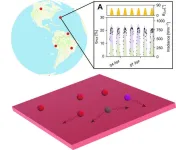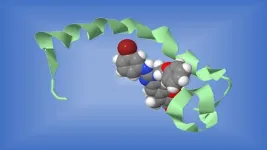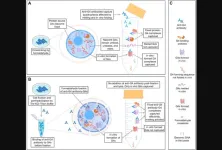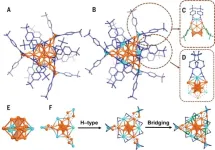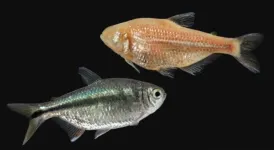(Press-News.org) A team from the University of Ottawa's Faculty of Medicine has completed an exciting new study that reveals the inner workings of gene mutations that result in an ultra-rare syndrome with fewer than 100 reported cases since its first description in the early 1960s.
The hard-won research discovery may accelerate the development of a treatment for Borjeson-Forssman-Lehmann Syndrome (BFLS), a neurodevelopmental disorder linked to the X chromosome that’s characterized by seizures, intellectual disability, and behavioural disturbances. Children born with this devastating disease typically also exhibit physical symptoms including distinctive facial features and growth defects such as tapered fingers.
Published in EMBO Reports, the rigorous study’s results could likely have broader impact, potentially brightening treatment prospects for other rare X-linked neurodevelopmental syndromes.
“The study of rare diseases of neurodevelopmental disorders and cognitive impairments advances our understanding of underlying mechanisms of disease pathogenesis and lays the foundation for the design of novel therapeutics,” says senior author Dr. Arezu Jahani-Asl, Canada Research Chair in Neurobiology of Disease, an associate professor in the Department of Cellular and Molecular Medicine and affiliate investigator at The Ottawa Hospital.
The project started by characterizing PHF6 gene regulation of the genome in the developing cortex of an embryonic mouse brain, according to Dr. Jahani-Asl, whose research program is centered on developing novel therapeutic strategies for devastating brain diseases. Employing computational approaches and multiomics, a biological analysis approach that provides nuanced data on how biological systems interact, they identified a panel of ephrin receptors as direct downstream targets.
First author Dilan Rasool, a visiting scholar at uOttawa who is a member of Dr. Jahani-Asl’s lab and a PhD candidate at McGill, says she used several different mouse models of the disease and established that they exhibited altered neural stem cells and progenitor populations, as well as deregulation of ephrin receptors, which are proteins involved in wide range of processes in developing human embryos.
The consequence of this phenomenon, according to Dr. Jahani-Asl, is that the “Eph-A” family of receptors are a viable transcriptional target of the PHF6 gene and may “represent a therapeutically exploitable target” for BFLS and other X-linked intellectual disability disorders (XLID).
“The goal is to translate these discoveries into practical applications that could benefit individuals affected by XLID and other cognitive disorders stemming from neural stem cell misregulation,” Dr. Jahani-Asl says.
The project’s reviewers praised the innovative, methodical work. One reviewer wrote: “The authors solve the molecular mechanisms of how Phf6 mutants cause neurogenic defects in BFLS. The discovery of Phf6-EphA regulatory pathway connects a rare disease to a conventional neurogenic molecule, which largely accelerates the development of BFLS treatment.”
The study was supported by funding from NSERC and CIHR. The team included international and national collaborators and uOttawa colleagues including Drs. Vahab Soleimani, Ruth Slack and David Picketts.
END
Shining a light on the underpinnings of rare disease impacting children
The rigorous study led by Canada Research Chair Dr. Arezu Jahani-Asl could have big implications for similar X-linked disorders that hobble the formation of new brain cells.
2024-03-18
ELSE PRESS RELEASES FROM THIS DATE:
Landmark study shows that ‘transcendent’ thinking may grow teens’ brains over time
2024-03-18
Scientists at the USC Rossier School of Education’s Center for Affective Neuroscience, Development, Learning and Education (CANDLE), have shown for the first time that a type of thinking, that has been described for over a century as a developmental milestone of adolescence, may grow teenagers’ brains over time. This kind of thinking, which the study’s authors call “transcendent,” moves beyond reacting to the concrete specifics of social situations to also consider ...
Reimagining the future of solar energy
2024-03-18
Scientists are always on the lookout for ways to make our world a better place, and one area they're focusing on is solar energy. One idea in this area is to make solar cells more efficient by concentrating more solar light onto them. While investigating this recently, a group of scientists at the Cavendish Laboratory and AMOLF (Amsterdam NL) have found that improving solar cells efficiency in this way is harder than we might think but have discovered other avenues by which it might be possible to improve solar energy capture anywhere on the planet.
The researchers ...
Metformin during pregnancy impacts offspring brain development
2024-03-18
With the rise in gestational diabetes and metabolic disorders during pregnancy, metformin is also being prescribed more frequently. Although it is known that the oral antidiabetic agent can cross the placental barrier, the impacts on the brain development of the child are largely unknown. An interdisciplinary research team from the German Institute of Human Nutrition Potsdam-Rehbrücke (DIfE) have now been able to demonstrate in a mouse model that although metformin has positive effects in pregnant animals, it does not in the offspring. The results were published in the specialist ...
Johns Hopkins Medicine-led team develops fluid biomarker for early detection of ALS and FTD
2024-03-18
Two progressively degenerative diseases, amyotrophic lateral sclerosis (ALS, commonly known as Lou Gehrig’s disease) and frontotemporal dementia (FTD, recently in the news with the diagnoses of actor Bruce Willis and talk show host Wendy Williams), are linked by more than the fact that they both damage nerve cells critical to normal functioning — the former affecting nerves in the brain and spinal cord leading to loss of movement, the latter eroding the brain regions controlling personality, behavior and language.
Research studies have repeatedly shown that in patients with ALS or FTD, the function of TAR DNA-binding protein 43, more commonly called TDP-43, ...
A new antibody capture method reveals G-quadruplex landscape and its regulation
2024-03-18
“[...] we present an improved method for G4 landscape determination and by applying it we show that sequence property-specific constraints of the nuclear environment mitigate G4 formation.”
BUFFALO, NY- March 18, 2024 – A new research paper was published in Oncotarget's Volume 15 on March 14, 2024, entitled, “G-quadruplex landscape and its regulation revealed by a new antibody capture method.”
In this new study, researchers Subhamoy Datta, Manthan Patel, Chakkarai Sathyaseelan, Chandrama Ghosh, Akanksha Mudgal, Divyesh Patel, Thenmalarchelvi Rathinavelan, ...
Researchers achieve >99% photoluminescence quantum yield in metal nanoclusters
2024-03-18
Prof. ZHOU Meng’s research team from the University of Science and Technology of China (USTC) of the Chinese Academy of Sciences (CAS), collaborating with Prof. WANG Quanming’s team from Tsinghua University (THU) achieved near-unity room-temperature photoluminescence quantum yield (PLQY) (>99%) in the near-infrared (NIR) emission of metal nanoclusters in solution. Their work was published in Science.
Gold nanoclusters (Au NCs) as NIR-emissive materials hold potential in biomedical applications. However, the PLQY of Au NCs in NIR region is typically low, often ...
Overeating and starving both damage the liver: Cavefish provide new insight into fatty liver disease
2024-03-18
KANSAS CITY, MO—March 18, 2024—Fatty liver, which can lead to liver damage and disease, can occur from both overeating and starvation. Now, new research shows how naturally starvation-resistant cavefish, unlike other animals, are able to protect their liver and remain healthy. The findings have implications for understanding and potentially addressing liver conditions in humans.
Researchers from the Stowers Institute for Medical Research in collaboration with Université Libre de Bruxelles in Belgium and Iowa State University ...
ReseNovel sacrificial layer “super-tetragonal” for freestanding oxide membranes
2024-03-18
A research team led by Prof. WU Wenbing and Prof. WANG Linfei from the University of Science and Technology of China (USTC), in collaboration with Prof. SI Liang’ s team from Northwest University, developed a new water-soluble sacrificial layer, “super-tectragonal” Sr4Al2O7 (SAOT), with broad tunability in lattice constants, which can be used to prepare high-quality freestanding oxide membrane. Their work was published in Science.
Freestanding oxide membrane is a type of low-dimensional quantum material that maintains single-crystal properties even ...
Novel design enhance thermal insulation and impact resistance in composite glass
2024-03-18
A research team led by Prof. NI Yong and Prof. HE Linghui from the University of Science and Technology of China (USTC) of the Chinese Academy of Sciences (CAS) has developed a new composite glass combining the nacre-inspired structure and shear stiffening gel (SSG) material, maintaining transparency while exhibiting excellent thermal insulation and impact resistance. Their work was published in Advanced Materials.
Bulk glass serves as an indispensable structural material in people’s daily lives. However, glass has poor thermal ...
Keeping in touch: Why businesses are cultivating relationships with former employees
2024-03-18
For many people, leaving a job can be like leaving a family — and because of the personal and professional bonds they’ve forged, many naturally stay in touch with their former coworkers and keep apprised of what’s happening in the organization.
But what happens when companies make a concerted effort to bolster those bonds, help former employees in their careers and keep them in the loop? According to new research from the UBC Sauder School of Business, it can have big benefits for both employees and employers.
For the paper, researchers studied ...
LAST 30 PRESS RELEASES:
Tsunami from massive Kamchatka earthquake captured by satellite
Hidden dangers in 'acid rain' soils
Drug developed for inherited bleeding disorder shows promising trial results
New scan could help millions with hard-to-treat high blood pressure
9th IOF Asia-Pacific Bone Health Conference set to open in Tokyo
Can your driving patterns predict cognitive decline?
New electrochemical strategy boosts uranium recovery from complex wastewater
Study links America’s favorite cooking oil to obesity
Famous Easter Island statues were created without centralized management
Captive male Asian elephants can live together peacefully and with little stress, if introduced slowly and carefully, per Laos case study of 8 unrelated males
The Galapagos and other oceanic islands and Marine Protected Areas (MPAs) may be "critical" refuges for sharks in the Tropical Eastern Pacific, as predatory fish appear depleted in more coastal MPAs t
Why are shiny colours rare yet widespread in nature?
Climate-vulnerable districts of India face significantly higher risks of adverse health outcomes, including 25% higher rates of underweight children
New study reveals spatial patterns of crime rates and media coverage across Chicago
Expanding seasonal immunization access could minimize off-season RSV epidemics
First-of-its-kind 3D model lets you explore Easter Island statues up close
foldable and rollable interlaced origami structure: Folds and rolls up for storage and deploys with high strength
Possible therapeutic approach to treat diabetic nerve damage discovered
UBC ‘body-swap’ robot helps reveal how the brain keeps us upright
Extensive survey of Eastern tropical Pacific finds remote protected areas harbor some of the highest concentrations of sharks
High risk of metastatic recurrence among young cancer patients
Global Virus Network statement on the Marburg virus outbreak in Ethiopia
'Exploitative' online money gaming in India causing financial, health and social harm, analysis shows
Mayo Clinic researchers identify why some lung tumors respond well to immunotherapy
The pterosaur rapidly evolved flight abilities, in contrast to modern bird ancestors, new study suggests
Farms could be our secret climate weapon, QUT-led study finds
New research by ASU paleoanthropologists gives valuable insight into how two ancient human ancestors coexisted in the same area
Therapeutic use of cannabis and cannabinoids
‘Cognitive Legos’ help the brain build complex behaviors
From inhibition to destruction – kinase drugs found to trigger protein degradation
[Press-News.org] Shining a light on the underpinnings of rare disease impacting childrenThe rigorous study led by Canada Research Chair Dr. Arezu Jahani-Asl could have big implications for similar X-linked disorders that hobble the formation of new brain cells.


